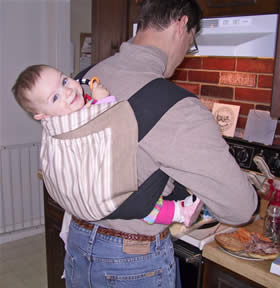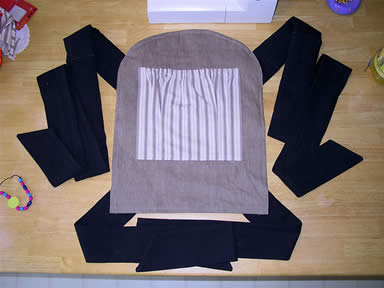All directions on this page are copyright to Beth M. I am only hosting them
for her.
Very special thanks is also given to the following, all of
which helped inspire me to make DIY MTs:
- the Kozy Carrier
(Kelley Mason's baby carrier, the first 'modern' American mei tai with padded
straps and headrest, and a pocket. Contains superb instructions on the various
ways to wear a MT safely.)
- the
FrankenKozy (Sarah's instructions for making a similar carrier, but with
wide, wrap-like straps)
- Sleeping
Baby Productions (Jan Andrea's site with many spectacular sling patterns)
- Beth's
Mei Tai (BMT) (Mei tai Pattern with wide straps and a sleeping hood)
Materials | Cutting the Fabric | Assembling the Straps | An
Optional Pocket | Assembling the Body
- Straps and body back: 2 yds (2.3 yds for x-long straps)
of bottom weight (9-10 oz) fabric (canvas, twill, corduroy, or denim)
- MT Body (front): 2/3 yd of decorative bottom weight fabric
- 1/2 yd polyester batting (8 oz is less bulky, 10 oz is
more padded)
- a
Quilting Ruler with 30, 45 & 60 degree biased lines
- thread to match both fabrics (don't skimp -- use
Gutermann or another high quality thread)
Optional Pocket:
- an additional 1/3 yd of your decorative bottom weight fabric
(or other fabric, if contrasting pocket is wanted)
- approx 1/3 yd of 5/8" elastic
First, before doing anything, wash and dry
your fabric -- I wash in warm (gentle cycle) and dry on medium using a mild
detergent for three reasons:
- It takes out any extra dye in the fabric. The black fabric
for this project was washed twice, due to the amount of dye that came out
during the first wash
(blech!);
- It takes out any chemicals in the fabric which may irritate
your baby's skin, or eat away at the fabric over time;
- It assures your carrier will not shrink after it is completed
( the black strap fabric in this project shrunk 4" in length after being
washed!).
the Straps:
the fastest way to 'cut' your strap fabric is to rip
it -- this assures that the straps are straight ( the fabric rips along the
weave) and it is SO much faster than cutting them.
First, TEST YOUR FABRIC to make sure it can be ripped
without damaging the fabric. If it can not, then I encourage you to invest
in a rotary cutter and cutting mat -- it will make cutting straps easier.
If your fabric DOES rip easily, make a small 1" cut in the fabric just
above the selvage edge, and rip the selvage off (I've found that the selvage
shrinks differently from the rest of the fabric, making it tough to lay flat). Then, measure how wide you want your fabric to be (see below) and make a small
1" snip, then let'er rip!
Length: Decide
how long you would like your top straps to be, then add 6" (which will
be sewn inside the body of the carrier). Usually, 60" long straps fit
'most', and 75" long straps fit most 'fluffy' people (size 20 and above). The bottom straps only need to be long enough to be tied around the waist
-- some people prefer a bow to a knot, so take that into account when deciding
on your bottom strap length, then add 5" (which, again, will be sewn
inside the carrier body). 30" is more than enough for most people.
Usually, the bottom straps are about 1/2 the length
of the top straps, which means you can rip three lengths of fabric, then cut
one in half to make the bottom straps.
Width: When sewn, the straps will be folded in half
lengthwise and stitched on one end, and then down the side, so the cut width
of your straps will be double the finished width, plus double the seam allowance
. Straps can vary in width from 3-4" (if you have narrow shoulders, you
may prefer narrower straps, and if you are broader, you may prefer closer
to 4"). Whatever width you decide is right for you, add your seam allowance
(I like to use 1/2" since it keeps the math simple), then double that
number to get your cutting width.
for example: 3 3/4" (finished
width) + 1/2" (seam allowance) = 4 1/4" (x 2) = 8 1/2" cut
width
| Tapered Ends (optional):
If you like tapered ends on your straps, fold your straps in half
lengthwise, then use your quilting ruler to make a 60 degree cut at one
end of your straps. Be sure to cut so that the longest part of your strap
is along the fold, or it will be bulky when turned right side out. |
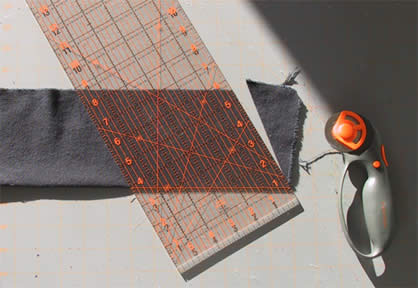 |
the Body
|
What Size?
Talk to 10 different people who wear MTs, and you'll
probably get 10 different answers about what size body they prefer.
Some things to think about are:
* What size is your baby?
* Do they like to have their arms in or out? |
Bodies which are too long easily can be folded at the waist to be shortened until the baby grows. However, bodies that
are too wide may be uncomfortable for a baby (however, newborn legs
can be fully tucked up inside the MT body in a 'frog-legged' position
for a snuggly nest). You want your baby's legs to be able to bend at the knees comfortably when they are seated inside the carrier.
People with younger babies may prefer a smaller body
size (14" x 18"), while those with toddlers may prefer something
larger (18" x 23")
To determine the right size for your baby, hold your
baby in front of you, as they would be when seated in the MT, and use
a tape measure to measure from just behind one knee, around the back
of the bum, to just behind the other knee to determine the width.
For the height, put the tape measure under your baby's
bum so it touches your belly, then bring it up around the baby's bum,
up the back, to the height you'd like the carrier to be. Then add approximately
3" ( the amount of the body that will be tucked up against you when the MT is apron-tied) -- this will be the height that works best for
you and your baby.
If you would like to have a curved headrest, cut a
curve that is about 4-5" in height. |
 |
|
Assembling the Straps |
top |
|
Shoulder Strap Padding
For this project, I only put padding in the shoulder straps, but some
people like to put padding in the bottom straps as well, as it can help
keep the straps from cutting into the sides of a 'well-padded' wearer.
I have found that canvas, being thicker and slightly stiffer than other
bottom weight fabrics (such as twill), is less likely to cut into people
at the waist, so I do not pad waist straps made of canvas, but I do when
using twill.
(If you do decide to pad the waist straps, be sure not to pad the straps
too far, or the padding will interfere with tying a tight knot. Measure
your waist, subtract the width of the carrier body, then divide that number
by two to get the MAXIMUM amount of waist padding you should have in each
strap.)
Cut two pieces of batting that are 1.5" narrower than the width
of your straps ( the batting in the photo to the right was cut a little
too wide and had to be trimmed later).
the length of the padding depends on your preference. When wearing my
baby on my front, I prefer my padding to extend below the crossed straps
on my back by a few inches, as it gives extra padding and helps keep the
straps spread wide. Others may prefer padding over the shoulder area only.
Again, use a tape measure to measure yourself and see how long you would
like your padding to be.
|

|
|
Fold the batting in half so that the fold is in the center of the fabric.
Place it 6 1/2" from the end of the strap, and 3/4" from the
seam edge. Pin it in place on both ends and in the middle. |
 |
|
Sewing the Straps:
Machine sew the batting to the strap in three places: at each end and
in the center.
Next, fold the strap fabric in half lengthwise, right sides together
and pin. Sew the tapered end and the long seam, leaving the end that will
attach to the carrier open for turning.
|
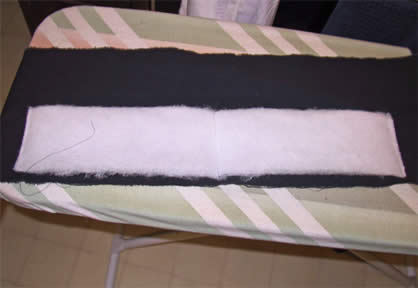 |
|
Notch the corners at the end of the straps so they will turn neatly. |
 |
|
Turn the strap right side out. Use a yard stick and
begin at the tip of the strap, pushing the tip inside itself.
Ease the area where the batting is attached carefully.
Once the strap is turned completely, use the yard stick
to make sure that the batting is spread out flat inside the strap.
|
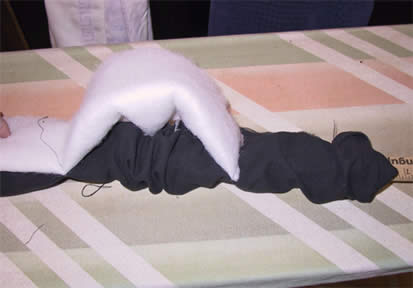
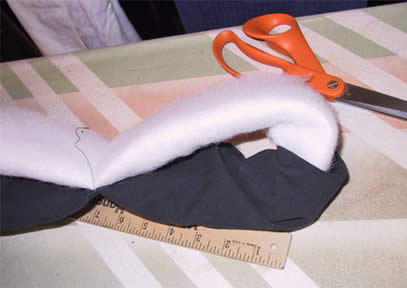
|
|
After turning, press the length of the strap with an
iron (be careful not to iron the batting very much, or it will melt/compress
-- learned that the hard way!).
Next, stitch across the width of the straps along the
ends of the batting again (going over the original stitching), so that the batting is securely fastened to both sides of the strap.
At this point, some may prefer to topstich around the
edges of the straps. With canvas, as a good ironing seems to be enough
for the straps to hold their shape, but a less stiff fabric like twill
might benefit from topstitching.
Repeat for all four straps.
Photo of bottom strap, pressed and
ready to be attached to the MT body --> |
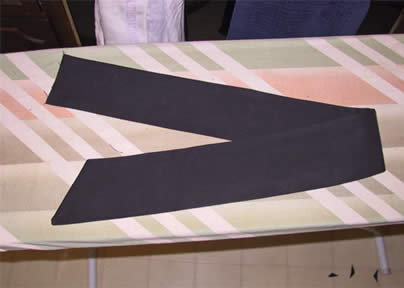 |
|
A pocket can be a nice feature to have on a MT; some
people like to have them so they can slip in a cell phone, wallet, or
even an extra diaper, but others feel they ruin the 'lines' of the MT.
On my first MT, I used a BMT-style
pocket (which has openings on the side ra ther than on the top), but
found that I was not as dexterous as Beth, and couldn't reach it when
wearing my daughter on my back. Also, being sewn on the top and the bottom, the pocket didn't expand as much as I needed, so I went back to a simple
design with pleats along the bottom (so the pocket can expand) and elastic
at the top.
First, cut a piece of fabric about 1 1/2" taller
than you want the finished pocket to be. The width of the fabric depends
on how large AND how 'puffy' you would like your pocket to be. The wider
you cut, the deeper your pleats will need to be, and the more your pocket
will puff out. If you are unsure at this point, follow the pleating directions
from the BMT instructions.
Make a casing for the elastic: along the top edge, turn
under 1/4" and press, then turn under 3/4" (for 5/8" elastic)
and press. Sew along the edge, creating the casing through which the elastic
will run (note: in photo, casing is at the bottom!).
On the other three sides, turn under 1/2" and press
(hint: press the bottom first, then press the sides -- this hides the
edges best). |
 |
|
To be honest, I totally winged the placement of the
pleats -- I wanted the stripes to match up at the bottom so they were
almost invisible, so the lines of the fabric were my guide.
I made the first pleat about 3" off center, then the next (smaller) one about 1 1/4" away from that one (centered
between the first pleat and the edge). As I went, I pressed the pleats.
Pocket placement: Center the pocked horizontally
(from right to left) on the body of your MT, but remember that the lower
part of the MT will be under your child's bottom, so you should place the pocket closer to the top of the MT (but not so high that it will interfere
with folding down the arch). |
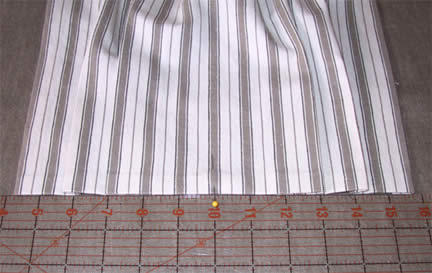 |
| After pressing the pleats, I
knew exactly how wide my finished pocket would be, so I knew how long the
elastic needed to be at the top. I cut the elastic to the correct length, then threaded it through the casing, using a zig-zag stitch to firmly attach
it at both ends of the casing. |
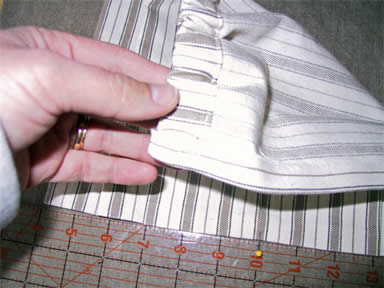 |
| After pinning down all three
sides, I did two rows of topstitching around the edges of the pocket (like the back pockets on your favorite pair of jeans, LOL), one as close to the
edge as possible, and the other about 5/8" in from the edge. |
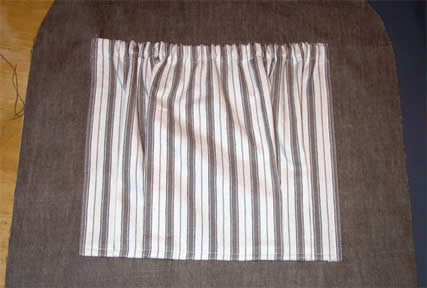 |
|
Overview: One of the most difficult parts of
making a MT is to attach the straps so that they are a) at the same angle
and b) finished off neatly where they meet the body. In this MT, the straps
are attached to the back panel of the MT, then the front and the back
are sewn together, leaving 4 holes where the straps are then pulled through
and finished off.
Hopefully these instructions, though long, will help
take away some frustration and leave you with nicely finished MTs.
Note: the striped fabric is the BACK of the MT,
and the tan fabric is the FRONT of the MT
Attaching the Straps to the Body Back:
Bottom Straps:
First, press under 3/4" at the bottom of the back body panel.
|
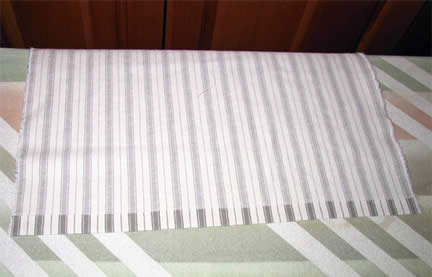 |
| Next, press under 5/8"
on each side of the lower part of the MT body, about 4-5" from the
bottom. |
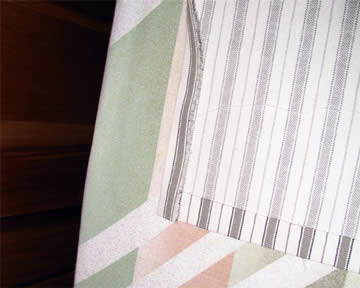 |
| On the two bottom straps, put
a dot in the middle of the strap using a fabric pencil, 5" in from the end. |
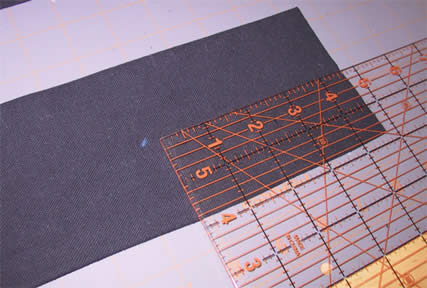 |
| Put the dot at the corner that
you just pressed at the bottom of the MT, then use your quilting ruler to
set the strap at a 45 degree angle to the bottom edge (in the photo, the
left edge of the strap is along the 45 degree line of the ruler). |
 |
| Pin both straps in place, then
topstich along the very edge of the MT body, ONLY where the strap meets the body (hint: start your stitching about 1/8" onto the strap, and
stop 1/8" before the strap ends (ie, don't go off the edges of the
straps). This will make things easier later on -- trust me! |
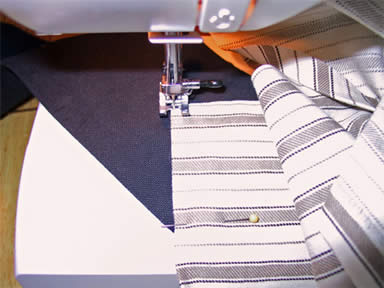 |
| After stitching along the edge,
turn the MT over and stitch a boxed "X" at the end of the straps
to make the connection good and strong: |
 |
|
the Top Straps:
Angle: Preferences vary greatly on the angle people use to attach their straps at the top of the carrier. You will see everything from completely
horizontal (like a My
Bei Bei) to nearly vertical. Some find that attaching the top straps
closer to a 60 degree angle will snug the baby in more tightly, while
attaching the straps at closer to a 45 degree angle gives the baby a little
more wiggle room.
Placement: Part of where you attach your straps will depend on
how wide your MT is -- some people find placing the straps on the straight
edge of the sides is better for smaller bodied MTs, while wider-bodied
MTs work better with the straps placed slightly on the curve.
I created a pattern on paper and drew the strap attachment location on
it, as well as the strap angle, to help me with placement when pinning
the straps on.
Press under 5/8" along the area where the straps will attach: |
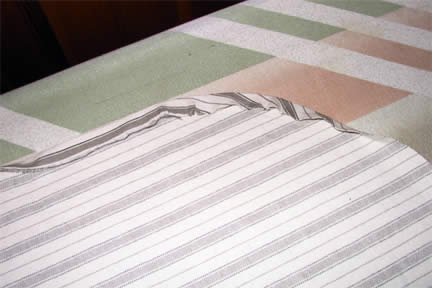 |
|
Next, use your quilting ruler to measure down from the
top of the arch to make sure the straps are attached at the same spot
on both sides, placing the strap so the padding starts about 1/2"
from the carrier body. Then, pin the shoulder straps in place, and topstitch
along the edge, just as was done at the bottom.
Note: while it's not a big deal for the angle to be
off by a few degrees in your strap placement, it IS important that your
straps match each other, or your baby will lean to one side and be uncomfortable.
One way to make sure the angles match exactly is to attach one strap,
then fold the carrier in half along the midline, then attach the second
strap, using the first one as a guide.
|
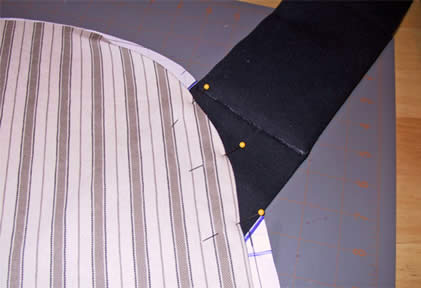 |
|
Cut a piece of batting to fit the top 1/2 of the body panel -- you can
cut it a little large around the arch at this point -- you can trim it
to size later.
Place the batting UNDER straps before stitching the X-box reinforcement
at the end of both straps (this helps to hold the batting in place). |
 |
|
Assembling the Body Pieces:
Pin back to front, RIGHT SIDES together (very important!). The batting
has been pinned out of the way temporarily for sewing.
Alternate method: In more recent MTs, I've found it is easier to go ahead
and pin the padding along the top of the arch and sew it into the seam,
but be sure to trim away the extra padding as close to the stitching as
possible (so it won't be lumpy). This way, you won't have to worry whe ther
your padding has been secured in the stopstitching fur ther along. You
can do the same along the side seams below the straps. |
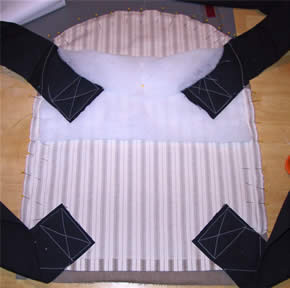 |
|
As you pin the two body pieces together, try to pin
as close as possible to the straps, without actually catching the straps.
Making a very small snip in the body fabric close to the straps helps
make pinning easier.
But, BE CAREFUL not to snip too close to the stitching!!
Stitch around the outside of the carrier, right up to
within 1/4" of the straps, leaving the bottom completely open at
this point. |
 |
|
After stitching, go back to the top of the carrier and
notch the fabric on the top seam so it will turn more neatly.
Also, at this time, trim the batting as close as possible
to the line of stitching along the arch. |
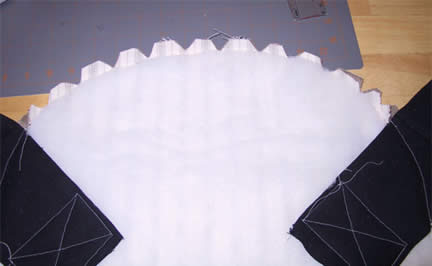 |
|
Preparing the Strap 'Gaps' for Finishing:
BEFORE you turn the carrier right-side out, there is
a little work that you can do which will make finishing so much easier.
the Bottom Gaps:
Heat up your iron, then turn up the bottom edge of the
front, aligning it to match the bottom edge of the back, then press. Do
the same for the side seam (just where the strap meets the body). This
makes lining up the two sides much easier. |
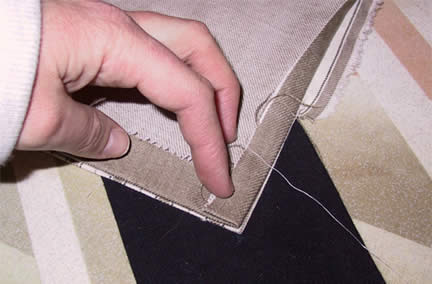 |
|
the Top Gaps:
Fold the front fabric along the edge of the top straps
so that it matches the material underneath, and press it back (in the
photo to the right, the white striped fabric from the back can be seen
just barely peaking out from underneath). |
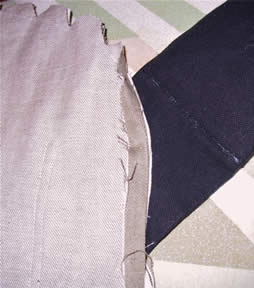 |
| Notching the fabric along the
curve helps it to lay flat -- just be careful not to snip too close to the
edge. |
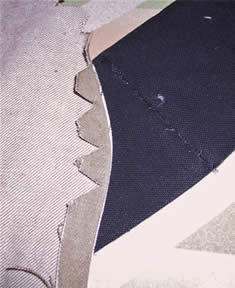 |
|
Un-pin the batting and turn the carrier right-side out
through the bottom, pulling the straps through the four holes.
Press the outside edges of the carrier (be careful not
to press the batting too much). Then reach inside from the bottom and
smooth out the batting so that it lays nice and flat, and snugged up to
the seam at the top of the arch.
Pinning the Strap Gaps:
You will see that, in addition to having your strap
gap seams already neatly pressed, there is also a line of stiching to
guide you where to pin the body to the strap. No guesswork involved! Just
pin the body to the straps, overlapping the guide stitching slightly.
|
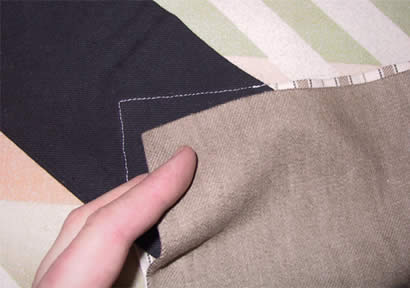
|
| Topstich along the very edge
of the body where it meets the straps. If the front fabric and back fabric
are two very different colors as these are, thread the top of the machine
with thread which is the color of the top piece you're working on, and thread
the bobbin with thread that matches the color of the bottom piece -- your
seam will almost disappear on BOTH sides. |
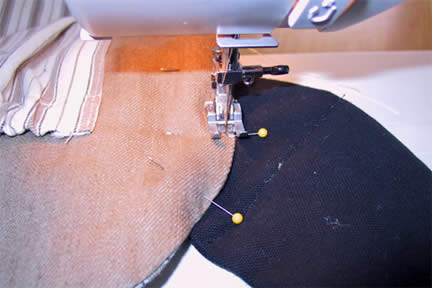 |
|
Finishing
After you have smoo thed the batting down inside the
carrier and made sure it is laying flat against the seam of the arch,
pin the bottom of the MT body closed.
Finally, topstich around the entire carrier, about 5/8"
in from the edge. This will close up the bottom hole. Be sure that you
are able to catch the folded edge in your stitching. You also want to
be sure that you catch the batting in your topstitching along the top
arch.
|
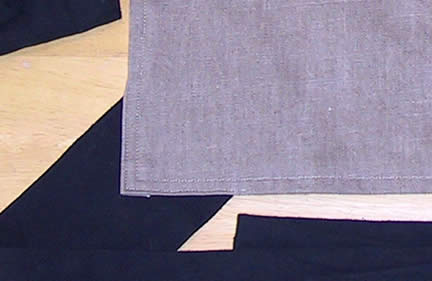 |
All content, barring that which is otherwise attributed, is ©2023 to
Jan Andrea. If you wish to use my content on another page, please email before
doing so, even for content with the Creative Commons licenses. Text/images used
elsewhere must be attributed to me. Be advised that I will pursue copyright
violations.

